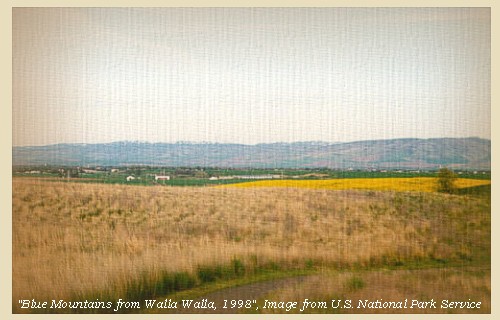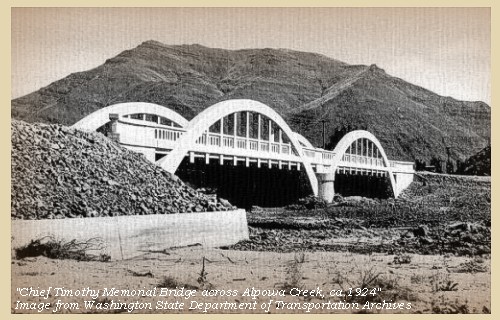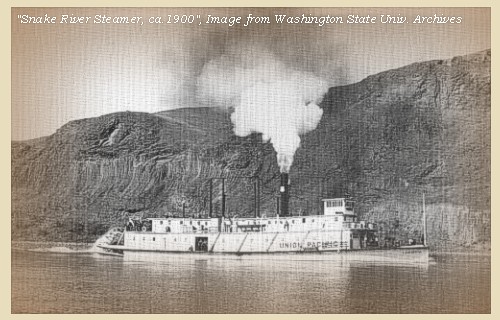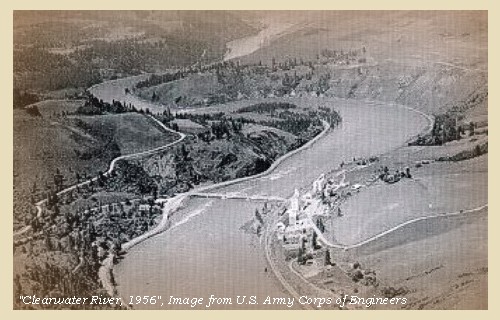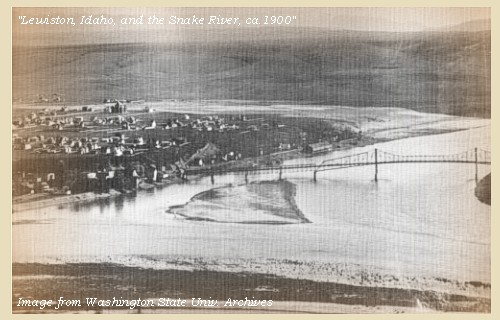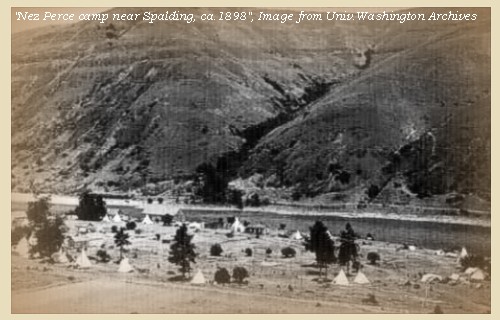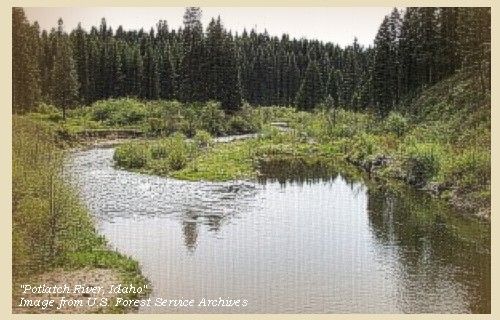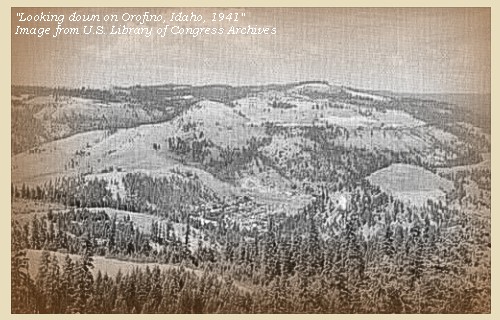The Volcanoes of
Lewis and Clark
Lewis and Clark
|
May 4 - June, 1806 To The Rockies - Snake River to Long Camp |
|
Home
The Volcanoes of Lewis and Clark Map of the Journey Volcanoes, Basalt Plateaus, Major Rivers, etc. The Volcanoes Mount Adams, Mount Hood, Mount Jefferson, Mount Rainier, and Mount St. Helens CALENDAR of the Journey October 1805 to June 1806 Along the Journey Pacific Northwest Maps - Columbia River, Volcanoes, Flood Basalts, Missoula Floods, Geology, etc. The Corps of Discovery The Journey of Lewis and Clark About the Reference Materials The Journals, Biddle/Allen, DeVoto, Gass, Moulton, Topo Maps, and others USGS Lewis and Clark Links Links to USGS Websites highlighting the Lewis and Clark Journey Resources Publications Referenced and Websites Visited |
PREVIOUS
May 1-3 The Walla Walla Shortcut, Overland, Touchet to the Snake |
May 4 - June
To the Rockies Snake River to Long Camp Blue Mountains, Alpowa Creek, Chief Timothy State Park, Snake River, Washington State Highway 12, Clearwater River, Lewiston (Idaho) and Clarkston (Washington), Nez Perce National Historical Park, Clearwater River, Lapwai Valley and Spalding (Idaho), Potlatch River, Great Lake River, Jacks Creek, Big Canyon Creek, Orofino (Idaho), Geology of the Camas Prairie, Kamiah (Idaho), Long Camp |
BEGIN
The Volcanoes of Lewis and Clark Lewis and Clark begin their Journey through the Pacific Northwest |
|
Heading for Home - May 1806
To the Rockies - Snake River to Long Camp |
| Lewis and Clark's camp of May 3, 1806 was on Pataha Creek, near the cities of Pataha and Pomeroy, Washington, near the foot of the old McKeirnan grade. |
| Sunday, May 4, 1806 |
| After a disagreeable night, we collected our horses at an early hour. and proceeded with a continuation of the same weather. We are now nearer to the southwest mountains [Blue Mountains], which appear to become lower as they advance towards the northeast. |
| We followed the road over the plains [Alpowa Ridge], north 60? east, for four miles to a ravine, where was the source of a small creek [Stember Creek, which flows into Alpowa Creek just west of Clayton Gulch], down the hilly and rocky sides of which we proceeded for eight miles [down Alpowa Creek] to its entrance into Lewis's river [Snake River] about seven miles and a half above the mouth of the Kooskooskee [Clearwater River]. ...... |
| "... the hills of the creek which we decended this morning are high and in most parts rocky and abrupt. one of our packhorses sliped from one of those hights and fell into the creek with it's load consisting principally of ammunition but fortunately neith the horse nor load suffered any material injury ..." [Lewis, May 4, 1806] |
| The soil of the plain is good, but it has no timber. The range of southwest mountains [Blue Mountains] is about fifteen miles above us, but continues to lower, and is still covered with snow to its base. After giving a passage to Lewis's river [Snake River], near their northeastern extremity, they terminate in a high level plain between that river and the Kooskooskee [Clearwater River]. ...... |
| Back on the Snake |
| Sunday, May 4, 1806 ... Continued |
| After our repast we continued our route along the west side of the river [Snake River's left bank, which today Washington State Highway 12 follows], where as well as on the opposite shore, the high hills approach it closely, till at the distance of three miles we halted opposite to two houses: the inhabitants consisted of five families of Chopunnish, among whom were Tetoh, or Sky, the younger of the two chiefs who accompanied us in the autumn to the great falls of the Columbia, and also our old pilot who had conducted us down the river to the Columbia. |
| They both advised us to cross here [near Chief Timothy State Park, Washington, see above for more information], and ascend the Kooskooskee [Clearwater River] on the northeast side, this being the shortest and best route to the forks of that river, where we should find the Twistedhair, in whose charge we left our horses, and to which place they promised to show us the way. We did not hesitate to accept this offer, and therefore crossed with the assistance of three canoes; but as the night was coming on, we purchased a little wood and some roots of cows, and encamped, though we had made only fifteen miles to-day. ...... |
|
|
|
The Camp - May 4, 1806:
About 3 miles below Clarkston, Washington. |
| Back on the Clearwater |
| Monday, May 5, 1806 |
| We collected our horses, and at seven o'clock set forward alone ...... Our road was across the plains for four and a half miles, to the entrance of the Kooskooskee [Clearwater River]. |
| Today at the junction of the Clearwater River with the Snake River lies Lewiston, Idaho, and Clarkston, Washington, and the entrance to the Nez Perce National Historic Park. |
| We then proceeded up that river [Clearwater River], and at five miles reached a large mat house, but could not procure any provisions from the inhabitants, but on reaching another three miles beyond, we were surprised at the liberality of an Indian, who gave captain Clarke a very elegant gray mare, ...... Four miles beyond this house we came to another one, containing ten families, where we halted, and made our dinner ...... |
| "... about noon we came to another small Village opposite the mouth of cottonwood creek [Lapwai Creek and the site of today's Spalding, Idaho] where we bought 2 dogs and dined & proceed on to Colters Creek [Potlatch River] & pah-map village where we camped ..." [Ordway, May 5, 1806] |
| After dinner we proceeded to the entrance of Colter's creek, [Potlatch River] at the distance of four miles, and having made twenty and a half miles, encamped on the lower side of it. Colter's creek [Potlatch River] rises not far from the Rocky mountains, and passing in the greater part of its course through a country well supplied with pine, discharges a large body of water. It is about twenty-five yards wide, with a pebbled bed and low banks. ...... |
| "... the natives have a considerable salmon fishery up Colter's Creek [Potlatch River] . this stream extends itself to the pirs of the rocky mountains and in much the greater part of it's course passes through a well timbered pine country it is 25 yds. wide and discharges a large body of water. the banks low and bed formed of pebbles ... ..." [Lewis, May 6, 1806] |
|
|
|
The Camp - May 5, 1806:
Along the Clearwater River, south side of the Potlatch River. |
| Tuesday, May 6, 1806 |
| We here found three men, of a nation called Skeetsomish, who reside at the falls of a large river, emptying itself into the north side of the Columbia. This river takes its rise from a large lake in the mountains [Lake Coeur d'Alene], at no great distance from the falls where these natives live. We shall designate this river, hereafter, by the name of Clarke's river [???], as we do not know its Indian appellation, and we are the first whites who have ever visited its principal branches; for the Great Lake river mentioned by Mr. Fidler, if at all connected with Clarke's river, must be a very inconsiderable branch. To this river, moreover, which we have hitherto called Clarke's river, which rises in the southwest mountains [Oregon Cascades], we restored the name of Towahnahiooks [Deschutes River], the name by which it is known to the Eneeshurs. ...... |
| "... at this place ... [at their camp of May 5, 1806] ... we met with three men of a nation called the Skeets-so-mish who reside at the falls of a large river disharging itself into the Columbia on it's East side to the North of the entrance of Clark's river. this river they informed us headed in a large lake in the mountains and that the falls below which they resided was at no great distance from the lake. these people are the same in their dress and appearance with the Chopunnish, tho their language is intirely different a circumstance which I did not learn untill we were about to set out and it was then too late to take a vocabulary. The river here called Clark's river is that which we have heretofore called the Flathead river, I have thus named it in honour of my worthy friend and fellow traveller Capt. Clark. for this stream we know no indian name and no white man but ourselves was ever on it's principal branches. the river which Fidler calls the great lake river may possibly be a brance of it but if so it is but a very inconsiderable branch and may as probably empty itself into the Skeetssomish as into that river. the stream which I have heretofore called Clark's river has it's three principal sources in mountains Hood, Jefferson & the Northern side of the S. W. Mountains and is of course a short river. this river I shall in future call the To-wannahiooks river it being the name by which it is called by the Eneshur nation. ..." [Lewis, May 6, 1806] |
|
|
|
Great Lake River:
The "Great lake River" appears on Aaron Arrowsmith's map of 1802, based on information from Peter Fidler. It headed near the Saskatchewan and ran into Mackenzie's "Tacoutche-Tess" River, which was assumed to be the Columbia or a major tributary thereof. No known river really matches the description. The captains were now trying to fit this largely conjectureal stream into their own increasing knowledge of Western geogrphy by making it a tributary of eithr Clark's River or the "Skeetsomish." -- Moulton, v.7 |
| About two o'clock we collected our horses and set out [proceeding up the Clearwater River], accompanied by Weahkoonut, with ten or twelve men, and a man who said he was the brother of the Twistedhair. |
| "... The Kooskooske river may be safely navigated at present all the rocks of the sholes and rapids are perfectly covered; the current is strong, the water clear and cold. this river is rising fast. The timber of this river which consists principally of the long leafed pine which commences about 2 miles below our present encampment on Colters Creek ..." [Clark, May 6, 1806] |
| At four miles we came to a single house of three families, but we could not procure provisions of any kind; and five miles further we halted for the night near another house, built like the rest, of sticks, mats and dried hay, and containing six families. ...... |
|
|
|
The Camp - May 6, 1806:
On the Clearwater River, below Pine Creek. |
| Wednesday, May 7, 1806 |
| We proceeded up the river with the brother of the Twistedhair as a guide. The Kooskooskee [Clearwater River] is now rising fast, the water is clear and cold, and as all the socks and shoals are now covered, the navigation is safe, notwithstanding the rapidity of the current. The timber begins about the neighbourhood of Colter's creek [Potlatch River], and consists chiefly of l ong-leafed pine. After going four miles, we reached a house of six families, below the entrance of a small creek [Bedrock Creek], where our guide advised us to cross the river, as the route was better, and the game more abundant near the mouth of the Chopunnish. [North Fork Clearwater River]. We therefore unloaded, and by means of a single canoe, passed to the south side in about four hours, during which time we dined. An Indian of one of the houses now brought two canisters of powder, which his dog had discovered under ground in a bottom some miles above [at the mouth of Jack's Creek, near Lenore, Idaho] . We immediately knew them to be the same we had buried last autumn ...... We set out at three o'clock, and pursued a difficult and stony road for two miles, when we left the river and ascended the hills on the right, which begin to resemble mountains. But when we reached the heights, we saw before us a beautiful level country ...... |
|
|
|
Jacks Creek:
Jacks Creek is approximately 8 miles in length and courses in a northerly direction through a canyon area, has well developed riparian vegetation, and discharges into the Clearwater River at River Mile 36. Lewis and Clark refer to this creek as "Canister run", so named for the location the men stored canisters of gunpowder in 1805 for their return journey east in 1806. -- Bonneville Power Administration Website, 2004, and Clearwater Historical Society Website, 2002 |
| As we entered the plain Neeshnepahkee, the Cutnose, overtook us, and after accompanying us a few miles, turned to the right to visit some of his people. ...... Having crossed the plain a little to the south of east, we descended a long steep hill, at the distance of five miles, to a creek six yards wide [Big Canyon Creek], which empties itself into the Kooskooskee [Clearwater River]. We ascended this little stream for a mile, and encamped at an Indian establishment of six houses, which seem to have been recently evacuated. Here we were joined by Neeshnepahkee, and the Shoshonee who had interpreted for us on the fifth. |
| "... in short it is a beautifull fertile and picturesque country. ... we called Musquetoe Creek in consequence of being infested with swarms of those insects on our arrival at it. ... here we remained all night ..." [Lewis, May 7, 1806] |
|
|
|
Big Canyon Creek:
Big Canyon Creek is approximately 30 miles in length and flows in a northerly direction before discharging into the Clearwater River at River Mile 42.5. -- Bonneville Power Administration Website, 2004 |
| From the plain we observed that the spurs of the Rocky mountains are still perfectly covered with snow, which the Indians inform us is so deep that we shall not be able to pass before the next full moon, that is, the first of June. ...... |
| "... The spurs of the rocky mountains which were in view from the high plain to day were perfectly covered with snow. The Indians inform us that the snow is yet so deep on the mountains that we shall not be able to pass them untill after the next full moon or about the first of June. others set the time at still a more distant period. this unwelcom intiligence to men confined to a diet of horsebeef and roots, and who are as anxious as we are to return to the fat plains of the Missouri and thence to our native homes ..." [Clark, May 7, 1806] |
| "... Here some of the natives came to our camp, and informed us, that we could not cross the mountains for a moon and an half; as the snow was too deep, and no grass for our horses to subsist on. We have the mountains in view from this place, all covered white with snow ..." [Gass, May 8, 1806] |
|
|
|
The Camp - May 7, 1806:
On Big Canyon Creek near Peck, Idaho. |
| Thursday, May 8, 1806 |
| Most of the hunters set out at daylight. By eleven o'clock they all returned, with four deer, and a duck of an uncommon kind ...... The mother of the Twistedhair, and Neeshnepahkeeook now drew a sketch, which we preserved, of all the waters west of the Rocky mountains. They make the main southern branch of Lewis's river [Snake River], much more extensive than the other, and place a great number of Shoshonee villages on its western side. Between three and four o'clock in the afternoon we set out, in company with Neeshnepahkeeook and other Indians, the brother of the Twistedhair having left us. Our route was up a high steep hill to a level plain, with little wood, through which we passed in a direction parallel to the river, for four miles, when we met the Twistedhair and six of his people. To this chief we had confided our horses and a part of our saddles, last autumn ...... |
| Lewis and Clark are on the plains a few miles west/southwest of Orofino, Idaho. |
| "... the road led us up a steep and high hill to a high and level plain mostly untimbered, through which we passed parrallel with the river about 4 miles when we met the 'Twisted hair" and a party of six men ... we informed the Cheifs that we should continue our march to the first water and encamp accordingly we moved on and the Indians all followed. about two miles on the road we arrived at a little branch which run to the wright. here we encamped for the evening having traveled 6 miles today ..." [Clark, May 8, 1806] |
|
|
|
The Camp - May 8, 1806:
A few miles west or southwest of Orofino, Idaho, on one of several small creeks flowing south into Little Canyon Creek. |
| Friday, May 9, 1806 |
| In the morning after sending out several hunters, we proceeded through a level rich country, similar to that of yesterday, for six miles [on the plains near Orofino, Idaho], when we reached the house of the Twistedhair, situated near some larch trees, and a few bushes of balsam fir. ...... As soon as we halted at this place, we went with the Twistedhair to the spot where he had buried our saddles, and two other young Indians were despatched after the horses. ...... Late in the afternoon, the Twistedhair returned with about half the saddles we had left in the autumn, and some powder and lead which was buried at the same place. Soon after, the Indians brought us twenty-one of our horses, the greater part of whom were in excellent order, though some had not yet recovered from hard usage, and three had sore backs. We were however very glad to procure them in any condition. ...... Our camp was in an open plain, and soon became very uncomfortable, for the wind was high and cold, and the rain and hail which began about seven o'clock, changed in about two hours to a heavy fall of snow, which continued till after six o'clock the next morning when it ceased, after covering the ground eight inches deep, and leaving the air keen and cold. |
|
|
|
The Camp - May 9, 1806:
Near modern Orofino, Idaho, on the Nez Perce Reservation. The Nez Perce brought 21 of the Corps' horses to them, cared for all winter by the Nez Perce. |
| To The Rockies |
| May 10 - June 9, 1806 |
| Our camp was in an open plain [camp of May 9, 1806, was near today's Orofino, Idaho], and soon became very uncomfortable, for the wind was high and cold, and the rain and hail which began about seven o'clock, changed in about two hours to a heavy fall of snow, which continued till after six o'clock the next morning [May 10, 1806], when it ceased, after covering the ground eight inches deep, and leaving the air keen and cold. We soon collected our horses, and after a scanty breakfast of roots, set out on a course S. 35o E. across the plains [Camas Prairie], the soil of which being covered with snow, we could only judge from observing that near the ravines, where it had melted, the mud was deep, black, and well supplied with quamash. The road was very slippery, and the snow stuck to the horses' feet and made them slip down very frequently. After going about sixteen miles, we came to the hills of Commearp creek [Lawyer Creek], which are six hundred feet in height, but the tops of which only are covered with snow, the lower parts as well as the bottoms of the creek having had nothing but rain while it snowed in the high plains. On descending these hills to the creek, we reached about four o'clock, the house of Tunnachemootoolt, where was displayed the flag which we had given him, raised on a staff: under this we were received with due form, and then conducted a short distance to a good spot for an encampment, on Commearp creek [Lawyer Creek]. ...... |
| "... we are now as near the Mountains as we can git untill Such time as the Snow is nearly gone of the mountains as we are too eairly to cross ..." [Ordway, May 10, 1806] |
|
|
|
Geology of the Camas Prairie:
Lewis County, on the south side of the Clearwater River, contains the steep sided Camas Prairie plateau underlain by Miocene lava flows of the Columbia River basalts. Poking through at several places are Cretaceous and Jurassic island arc rocks of the Accreted terranes. The Suture zone runs just east of the county line along the Clearwater River through Kamiah. These plateaus are unusual, since the flat ground is on top, and the cities are generally in narrow valley bottoms. The Clearwater River cuts through the plateau, following the track of the Cretaceous suture zone. -- Digital Atlas of Idaho Website, 2003 |
| the chief had a large leathern tent spread for us, and desired that we would make that our home whilst we remained at his village. We removed there, and having made a fire, and cooked a supper of horse-beef and roots, collected all the distinguished men present, and spent the evening [May 10, 1806] in explaining who we were, the objects of our journey, and giving answers to their inquiries. ...... |
|
|
|
The Camp - May 10, 1806 to May 12, 1806:
On Lawyer Creek, near Kamiah, Idaho. |
| we collected our horses [Tuesday, May 13, 1806] and proceeded for two miles in a southeastern direction [down Lawyer Creek], crossing a branch from the right [Sevenmile Creek], at the distance of a mile. We then turned nearly north, and crossing an extensive open bottom [just south of the present city of Kamiah]; about a mile and a half wide, reached the bank of the Kooskooskee [Clearwater River]. |
| Here we expected the canoe which they had promised; but although a man had been despatched with it at the appointed time, he did not arrive before sunset. We therefore encamped [on the banks of the Clearwater near the present town of Kamiah], with a number of Indians who had followed us from the village, |
|
|
|
The Camp - May 13, 1806:
On the banks of the Clearwater River, near the present town of Kamiah. |
| and in the morning [Wednesday, May 14, 1806], after sending out some hunters, transported the baggage by means of the canoe, and then drove our horses into the river, over which they swam without accident, although it is one hundred and fifty yards wide, and the current very rapid [Clearwater River]. We then descended the river about half a mile, and formed our camp on the spot which the Indians had recommended [today this camp is known as "Camp Chopunnish" or "Long Camp"]. It was about forty paces from the river, and formerly an Indian habitation; but nothing remained at present but a circle thirty yards in diameter, sunk in the ground about four feet, with a wall round it of nearly three and a half feet in height. In this place we deposited our baggage, and round its edges formed our tents of sticks and grass. This situation is in many respects advantageous. It is an extensive level bottom, thinly covered with long-leafed pine, with a rich soil, affording excellent pasture, and supplied, as well as the high and broken hills on the east and northeast, with the best game in the neighbourhood; while its vicinity to the river [Clearwater River] makes it convenient for the salmon, which are now expected daily. ...... |
|
|
|
"Long Camp":
The Lewis and Clark Expedition spent from May 14, 1806 to June 9, 1806 at a spot near Kamiah, Idaho, while waiting for winter to end in order to cross the Bitterroots and continue the eastward trek home. The camp at "Camp Chopunnish," was located near Kamiah, Idaho, on the Nez Perce Reservation, and was the longest camp of any, other than the three winter encampments of the Corps. The Corps had to wait until the snow melted in the mountains so that they could pass over the Continental Divide and return to the east. Today there is an interpretive sign at a pullout on U.S. Highway 12 (mile 68), approximately 1 mile east of Kamiah, Idaho. The actual camp site is approximately 2 miles downstream along the Clearwater River on private property. |
| The country along the Rocky mountains for several hundred miles in length and about fifty wide, is a high level plain; in all its parts extremely fertile, and in many places covered with a growth of tall long-leafed pine. This plain is chiefly interrupted near the streams of water, where the hills are steep and lofty; but the soil is good, being unincumbered by much stone, and possess more timber than the level country. Under shelter of these hills, the bottom lands skirt the margin of the rivers, and though narrow and confined, are still fertile and rarely inundated. Nearly the whole of this wide spread tract is covered with a profusion of grass and plants, which are at this time as high as the knee. |
| "... "The Country along the rocky mountains for Several hundred Miles in length and about 50 in width is leavel extremely fertile and in many parts Covered with a tall and opult. growth of the long leafed pine. near the Watercourses the hills are lofty tho' are covered with good Soil and not remarkably Stoney and possess more timber than the leavel country. the bottom lands on the Water courses are reather narrow and confined tho' fertile and Seldom inundated. this Country would form an extensive Settlement ..." [Clark, May 28, 1806] |
| Home | Previous |
If you have questions or comments please contact: GS-CVO-WEB@usgs.gov
June/July 2004, Lyn Topinka
The Volcanoes of Lewis and Clark Home Page | CVO Home Page


